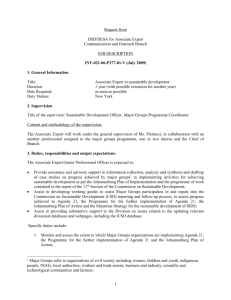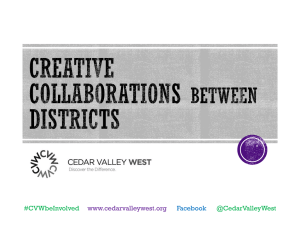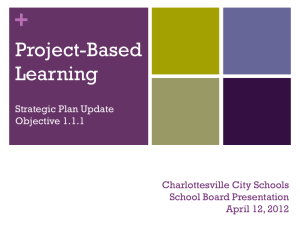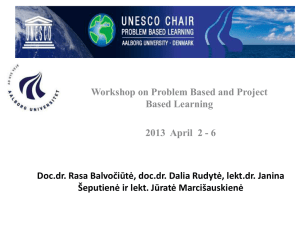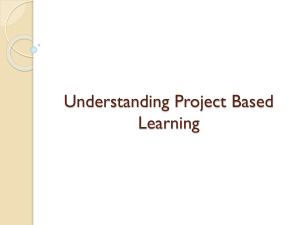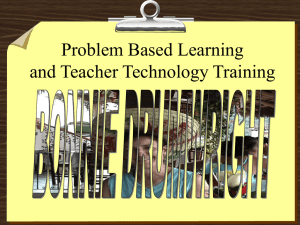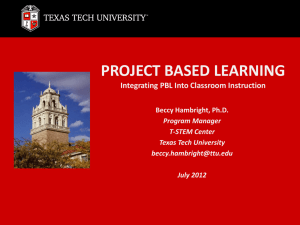The choice of PBL projects at YY-University is said to vary on
advertisement
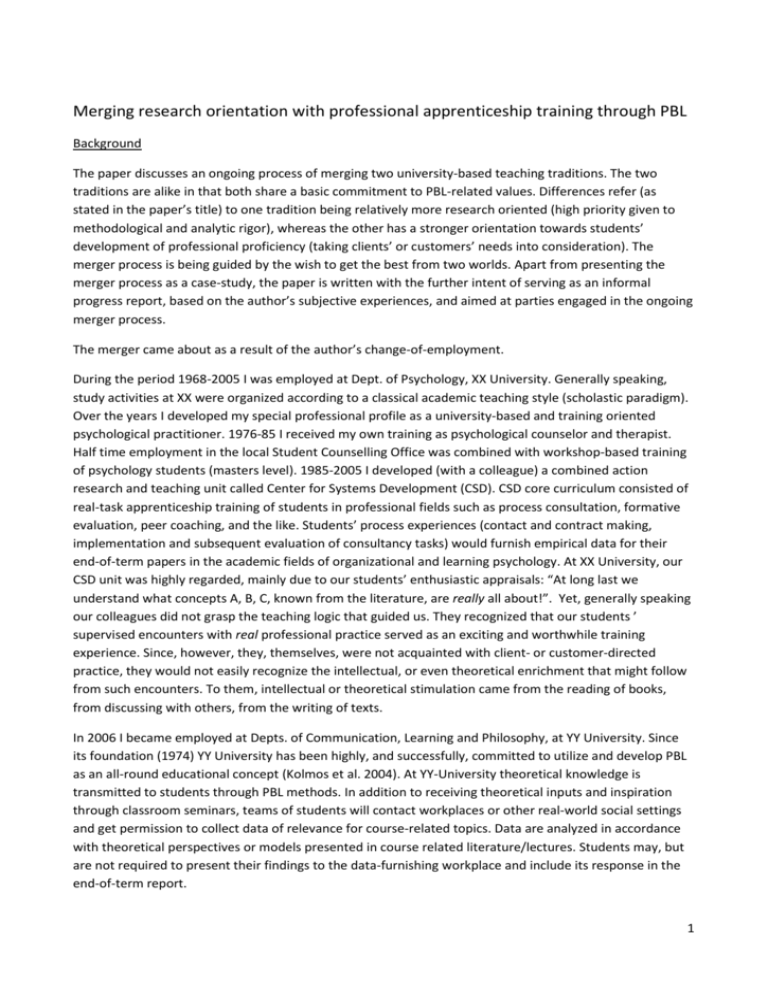
Merging research orientation with professional apprenticeship training through PBL Background The paper discusses an ongoing process of merging two university-based teaching traditions. The two traditions are alike in that both share a basic commitment to PBL-related values. Differences refer (as stated in the paper’s title) to one tradition being relatively more research oriented (high priority given to methodological and analytic rigor), whereas the other has a stronger orientation towards students’ development of professional proficiency (taking clients’ or customers’ needs into consideration). The merger process is being guided by the wish to get the best from two worlds. Apart from presenting the merger process as a case-study, the paper is written with the further intent of serving as an informal progress report, based on the author’s subjective experiences, and aimed at parties engaged in the ongoing merger process. The merger came about as a result of the author’s change-of-employment. During the period 1968-2005 I was employed at Dept. of Psychology, XX University. Generally speaking, study activities at XX were organized according to a classical academic teaching style (scholastic paradigm). Over the years I developed my special professional profile as a university-based and training oriented psychological practitioner. 1976-85 I received my own training as psychological counselor and therapist. Half time employment in the local Student Counselling Office was combined with workshop-based training of psychology students (masters level). 1985-2005 I developed (with a colleague) a combined action research and teaching unit called Center for Systems Development (CSD). CSD core curriculum consisted of real-task apprenticeship training of students in professional fields such as process consultation, formative evaluation, peer coaching, and the like. Students’ process experiences (contact and contract making, implementation and subsequent evaluation of consultancy tasks) would furnish empirical data for their end-of-term papers in the academic fields of organizational and learning psychology. At XX University, our CSD unit was highly regarded, mainly due to our students’ enthusiastic appraisals: “At long last we understand what concepts A, B, C, known from the literature, are really all about!”. Yet, generally speaking our colleagues did not grasp the teaching logic that guided us. They recognized that our students ’ supervised encounters with real professional practice served as an exciting and worthwhile training experience. Since, however, they, themselves, were not acquainted with client- or customer-directed practice, they would not easily recognize the intellectual, or even theoretical enrichment that might follow from such encounters. To them, intellectual or theoretical stimulation came from the reading of books, from discussing with others, from the writing of texts. In 2006 I became employed at Depts. of Communication, Learning and Philosophy, at YY University. Since its foundation (1974) YY University has been highly, and successfully, committed to utilize and develop PBL as an all-round educational concept (Kolmos et al. 2004). At YY-University theoretical knowledge is transmitted to students through PBL methods. In addition to receiving theoretical inputs and inspiration through classroom seminars, teams of students will contact workplaces or other real-world social settings and get permission to collect data of relevance for course-related topics. Data are analyzed in accordance with theoretical perspectives or models presented in course related literature/lectures. Students may, but are not required to present their findings to the data-furnishing workplace and include its response in the end-of-term report. 1 How did the merger process come about? During my years at XX University I knew about the PBL-concepts. In the seventies PBL had presented itself as a socially and politically committed alternative (Berthelsen et al. 1977) to the mainstream university teaching style practiced at my own workplace. As such PBL had served me as a definite personal inspiration in the process of gradually shaping my own teaching style (Willert 2007). For these reasons it felt natural to search for parallels between my own CSD-based style, and the prevailing local style, when, some five years ago, I became formally attached to YY University. The PBL teaching style at YY University has developed over a period of 37 years in a wide array of settings: dealing with different academic subject, entrenched in different local cultures, involving a wide variety of external co-operational partners, etc. During my five years of employment I’ve encountered no more than a narrow set of examples. Given my background as ‘self-made PBL-devotee’ I kept my eyes and ears open, looking for obvious similarities as well as apparent differences between CSD practice, as I knew it, and PBL practice, as I came across it at YY-University. As stated in the paper’s title, the most important difference I noticed between the two traditions concerned a distinction between ‘research orientation’ (prevalent at YY) versus ‘orientation towards professional apprenticeship training’ (prevalent in CSD tradition). I briefly return to this theme in the last section of the paper. My experiences in YY classrooms and discussions with co-teachers have led to various merger initiatives which I, myself, and a number of colleagues and/or system representatives have undertaken. Some of these initiatives have been informal in nature and would not necessarily have seemed very ‘foreign’ to YY University old-timers, had they been there to observe what went on. Classroom activities for which I have been responsible have been slightly twisted in a CSD direction, for the simple reason that it seemed appropriate and/or the student expressed an interest. The ease with which such ‘CSD twists’ have been implemented in classroom settings, and the general acceptance they’ve met from colleagues who heard about them or became partially involved, tell me that CSD practice, as evolved by myself and my former XX colleague, may indeed be considered part of the PBL-family of teaching practices. Other CSD-inspired initiatives have had a more formal, institutionalized quality involving organizational parties at YY-University other than myself. The Department where I’m working has committed itself to establish a LAB for Organizational Change and Consultation, partly based on CSD inspiration, as part of its long term development plan; a brief, programmatic description of LAB is furnished in an appendix following the last section of the paper proper. CSD components have been, or are being integrated in courses (master level) dealing with organizational learning and organizational psychology. Advanced study programs for experienced 2 practitioners are incorporating CSD-components by inviting students to become action researchers in their own home organizations (Coghlan & Brannick 2005; Willert et al. 2011). YY University has decided that a study be made aimed at identifying and describing existing examples of PBL-practice where students’ professional interaction with external co-operational partners (in line with the CSD tradition) is part of the course program. This study is intended to inspire further debates concerning researcher orientation/professional apprenticeship orientation in the PBL context. What are the special features of the CSD teaching tradition This section focuses on certain implications following from the orientation towards professional apprenticeship training that is inherent in the CSD tradition. I’ll use a PBL-catalogue from the introductory chapter in Kolmos et al. (2004: 15) to identify special features of CSD as a sub-tradition within PBL. The overall aim of this exercise is to prepare for discussions concerning the ways in which the ongoing merger process, if properly conducted, may lead to an overall quality improvement in teaching quality at YY University, namely (as stated in the introductory paragraph) by getting the best from two worlds. In the said catalogue PBL themes are described as being either problem based or theory based (“directed towards certain subjects”). – CSD projects are always problem oriented. Further than that, problem themes must fulfill certain criteria. At the outset, the problem theme is defined, not by the students, but by the external partners with whom the students co-operate during project activities. The choice of PBL projects at YY-University is said to vary on a continuum between an open variety (students are responsible for choosing) and a controlled variety (teacher is responsible for choosing). – CSD projects may cover the whole continuum. Open choice implies that groups of students are instructed to do their own search for organizational partners who may feel inclined to invite them into a co-operational relationship. Teacher stimulates shared reflection among students, and may be consulted by, or offer his supervisory services to students who feel the need. Controlled choice means that students work within a consultancy framework that has originally been established by the teacher, and with the teacher in the role as master consultant. PBL problems are said to vary widely. Examples mentioned in the catalogue: “dilemma or social discrepancy … an issue calling for an engineering solution … a question of turning the learning process in a certain direction”. – As stated above, CSD problems are, at the outset, defined by the co-operational partner. The problem refers to states of affairs that are somehow experienced by members of the partner organization as unsatisfactory. Contract negotiations between students and partner will lead to an adjusted, shared problem definition that will henceforth guide the students’ investigations and/or interventions. PBL project phases are said to “vary depending on the subject in question”. – In CSD, problem phases refer to the successive steps structuring the professional co-operation between student and co-operational partner: Initial contact contract negotiation – leading to a joint understanding of what will be the basic contents and goals of the project implementation of contract joint evaluation of project activities and results obtained closing of co-operational project. 3 The relation in PBL between courses and project is said to vary a lot – and so it does in CSD. – At XX University CSD-students would enter our classes richly endowed with theoretical knowledge of potential value for their supervised project activities. For this reason, teaching and training activities had a relatively narrow focus on students’ future needs in the project field. Among these needs were teamwork skills and skills related to observation and intervention. Generally speaking, YY students are much more skilled in social and practical project management. At YY University, broadly conceived theoretical tuition (through lectures and other classroom activities) takes up relatively more space in the preparation of students for project work. In PBL the extent of supervision varies widely – as is the case in CSD. – One specific feature of CSD supervision is worth mentioning – partly because students, whether in the XX or the YY context, often comment upon it as being unusual. I’ll call this unusual feature process oriented supervision as distinctly different from exam or report oriented supervision. Generally speaking, CSD projects place students in complex, shifting co-operational relationships with their external partners. Mutual expectations may have to be adjusted. Initial terms-of-contracts may have to be re-negotiated. Co-operational complexities of this kind are not ‘errors’ to be avoided. On the contrary, they are essential ingredients in the learning potential inherent in the CSD tradition. They also point at the need for teacher support. Through process oriented supervision the teacher helps students find their way in the relational entanglements emerging within their co-operation with project partners. Exam or report oriented supervision is described by the students as well known. It supports intellectual bridge building between the students’ experiential process and academically defined conceptual structures. In PBL groups vary in size, and so they do in the CSD tradition. – One group related feature in CSD concerns a strong commitment to organizational transparency and self-scrutiny. Student classes in a CSD framework are managed with the aim of helping students acquire theoretically valid and practically useful knowledge about the way organizational work units function and may be functionally improved. At the same time, these classes are, themselves, organized as work units. With the teacher in the role as leader and coach/supervisor, classes are structured with a view to getting certain jobs done. Students’ knowledge acquisition is supposed to develop, first and foremost, as a result of getting the jobs done. By participating in and reflecting upon the temporary organization taking shape through goal-directed interactivity among students and teacher, students may acquire an insider’s comprehension about organizational work units – as a supplement to the outsider’s comprehension they may acquire through their project-based interaction with the co-operational partner. How to get the best from two worlds? The paper describes a merger process between two teaching traditions: the YY/PBL tradition and the CSDtradition. The paper, including the appendix below, is one-sided, in that the CSD tradition has been described in far more detail than the YY/PBL tradition. This is due to the fact that (1) the CSD tradition is the one I know best; (2) the fact that the paper is written partly as a presentation of this tradition to YYcolleagues: The paper is intended as an active ingredient in the very merger process it describes. The figure below represents one small contribution towards rectifying the one-sidedness of the present paper. It hints at my present way of perceiving the relative educational strengths of the two teaching traditions that are involved in the merger process. It points out the ‘researcher virtues’ and the 4 ‘practitioner virtues’ which I see as the ideal learning outcomes for students participating in YY/PBL courses (as I’ve come across them), and courses guided by the CSD tradition respectively. YY/PBL-tradition (researcher virtues) Methodological and analytic rigor Theoretically grounded process design High degree of construct validity Self-detachment, objectivity CSD-tradition (practitioner virtues) Mental flexibility, skills in meaning negotiation In the moment-facilitation High degree of ecological validity Self-involvement, self-scrutiny In this context, I’ll leave the figure with no further comments or explanations. It seems obvious that the two virtue catalogues are mutually complementary. It is my hope that the figure may pave the way for further discussions about how to continue the ongoing merger process in ways that will allow teachers and students at YY University to get the best from two worlds. Getting the best from two worlds may help building bridges between YY University as (1) a research institutions; (2) a professional training institution. Appendix LAB for Organisational Change and Consultation LAB creates a space for mutually rewarding encounters between the fields of academic research, professional consultation and university-based teaching and training. LAB is a collaboration and research forum for practising theorists and theorising practitioners, for teachers who research and for researchers who teach, and for students and supervisors who are willing to expose themselves to professional challenges. LAB operates in three areas: Co-operational projects with external organizational partners allow us to work as facilitators of change, as researchers of complex organisational change processes and as providers of a learning space for the participating students. We offer teaching where cooperation between student and teacher is structured, partly, as a relation between professional apprentice (student) and master consultant (teacher). We do research in complex organisational processes of change. LAB is rooted in the research group CLIO (Centre for Learning in Organisations) located at the Department for Learning and Philosophy, Aalborg University (AAU). In line with the cross-facultary status of the department, LAB wishes to establish project-based co-operational links with teaching and research environments placed at all AAU-faculties. 5 With reference to Kurt Lewin (1890-1947; inspirational figure behind organisational consultation and action research), LAB will monitor its activities in accordance with ‘Lewin’s triangle’, cf. the following quotation and figure: ”This and similar experiences have convinced me that we should consider action, research and training as a triangle that should be kept together for the sake of any of its corners” <Lewin, K. (1948) Resolving Social Conflicts. N.Y. Harper & Brothers> Research Teaching Practice Coupling between practice and research implies that LAB-projects typically make use of an action research inspired methodology where intervention and investigation go hand in hand and function as prerequisites for each other. Project implementation takes place within cooperational partnerships, aimed at mutual learning, between LAB and public or private organizations. Coupling between teaching and practice implies that LAB (as one variety within the existing AAU/PBL-model) will develop teaching methods which allow supervisor-supported students to make active contributions (as process helpers, data collectors etc.) to projects involving external partners – in ways that make it possible for the involved students to use their project experiences as data for exam reports (learning by doing). Coupling between research and teaching implies that LAB, besides offering research-based teaching, is also committed to developing methods for teaching-based research. References: Berthelsen, J., Illiriis, K. & Poulsen, S.C. (1977) Projektarbejde – erfaringer og praktisk vejledning (Project work – experiences and practical guidance). Holstebro: Borgen Coghlan, D. & Brannick, T. Doing Action Research in your own Organization. London: Sage Kolmos, A., Fink, F.K. & Krogh, L. (eds.) (2004) The Aalborg PBL Model. Aalborg: Aalborg University Press Willert, S. (2007) Psykologi som håndværk – Psykologistudiet som håndværkeruddannelse (The psychologist as craftsman – teaching psychology as training in craftsmanship). In: Brinkmann, S. & Tanggaard, L. (eds.) Psykologi: forskning og profession (Psychology: Research and Profession). København: Hans Reitzel. Willert, S., Keller, H.D. & Stegeager, N. (2011) Academic Vocational Training: Bridging the Gap Between Educational Space and Work Space. The Electronic Journal of Knowledge Management. Vol. 9, 2, p 168-80 6 7
